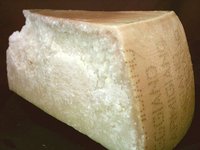» View the recipes involving parmesan
 Parmigiano-Reggiano is a hard-textured cheese, cooked but not pressed, named after the producing areas of Parma and Reggio Emilia, in Emilia-Romagna, Italy. It is widely described by connoisseurs as the king of cheeses. Cheeses resembling Parmigiano-Reggiano but not made in this area are known as parmesan cheese. Parmigiano-Reggiano is a hard-textured cheese, cooked but not pressed, named after the producing areas of Parma and Reggio Emilia, in Emilia-Romagna, Italy. It is widely described by connoisseurs as the king of cheeses. Cheeses resembling Parmigiano-Reggiano but not made in this area are known as parmesan cheese.
It is made from raw cow's milk, collected immediately after milking and partly skimmed by gravity. Traditionally, cows have to be fed only on grass or hay, producing grass fed beef. Only natural whey culture is (allegedly) allowed as a starter, together with calf rennet. The only additive allowed is salt. The product is aged an average of two years. The cheese is produced daily, and it can show a natural variability. The name is trademarked, and in Italy there is a legal exclusive control exercised over its production and sales by the Parmigiano-Reggiano cheese Consorzio (created by a governmental decree). There are strict criteria each wheel must meet early in the aging process, when the cheese is still soft and creamy, to merit the official seal and be placed in storage for aging. Cheese which fails to meet these criteria is removed and fed to pigs, which are then used to produce prosciutto di Parma. Uses of the cheese include being grated over pasta or eaten in chunks with balsamic vinegar.
Season specials: Easter Recipes, Passover Recipes, Christmas Recipes, Season Recipes, Xmas Recipes
|